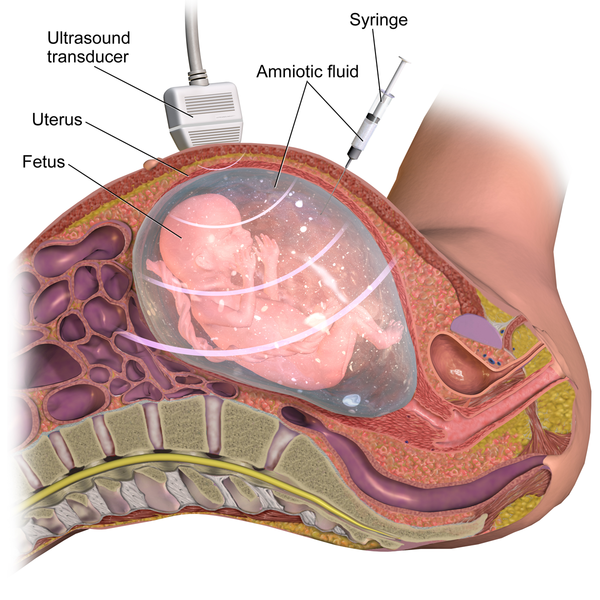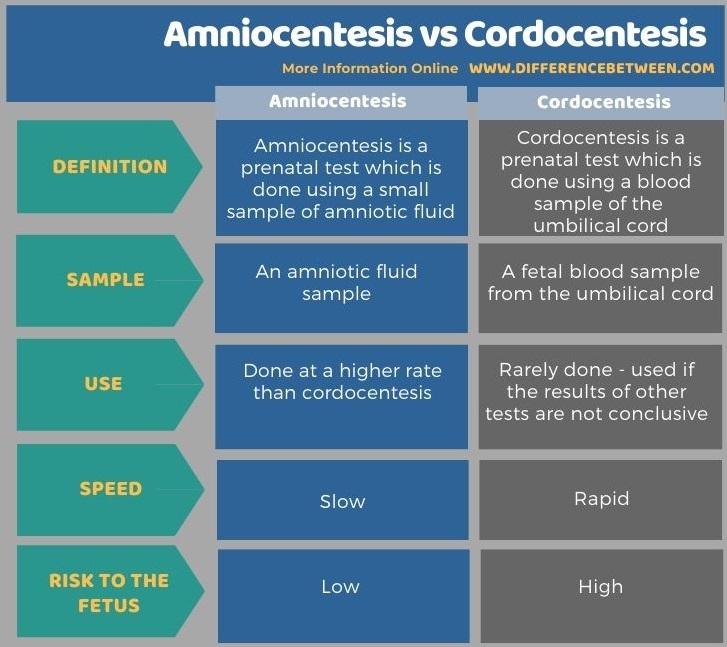The key difference between amniocentesis and cordocentesis is that amniocentesis is done using a sample of amniotic fluid while cordocentesis is done using a blood sample of the umbilical cord.
Amniocentesis and cordocentesis are two prenatal diagnostic procedures that are used to detect chromosomal abnormalities and other fetal medical conditions. Both procedures are invasive. Hence, it is necessary to perform these tests under direct, continuous ultrasound visualization. In amniocentesis, an amniotic fluid sample should be withdrawn while in cordocentesis, a fetal blood sample should be withdrawn. Therefore, amniocentesis is a low-risk procedure than cordocentesis. But both procedures carry the risks of miscarriage.
CONTENTS
1. Overview and Key Difference
2. What is Amniocentesis
3. What is Cordocentesis
4. Similarities Between Amniocentesis and Cordocentesis
5. Side by Side Comparison – Amniocentesis vs Cordocentesis in Tabular Form
6. Summary
What is Amniocentesis?
Amniocentesis is a prenatal test done on a pregnant woman who is in 16th to 20 weeks of pregnancy and thought to be at higher risk of delivering a child with a birth defect. This test is mainly used for detecting fetal abnormalities (birth defects) such as Down syndrome, cystic fibrosis or spina bifida. This test uses 15 to 20 ml of amniotic fluid sample. In order to extract a fluid sample from the surrounding sac of the fetus, this test uses a very thin needle. Therefore, this procedure is an invasive procedure similar to cordocentesis.

Figure 01: Amniocentesis
The test result usually comes within three days, but it may take up to three weeks’ time. Amniocentesis is a painless test, yet some may feel mild discomfort and slight bruising at the injection site. Amniocentesis rarely causes complications. However, some may experience complications such as infection, abortion and vaginal leakage, etc.
What is Cordocentesis?
Cordocentesis or precutaneous umbilical blood sampling is a prenatal diagnostic test which uses a fetal blood sample from the umbilical cord. It is usually done after the 18th week of pregnancy. It is a quick test which gives results within three days’ time. However, this test is rarely done if other tests are not conclusive and the doctor recommends doing the test. This test can reveal whether there are defects or disorders in the baby’s chromosomes. Hence, this test is used to detect disorders in the fetus. Moreover, cordocentesis can provide information regarding the low platelet count and thyroid disorders. Not only that, but cordocentesis can also be used to give medication to the fetus through the umbilical cord, as well as blood transfusions.

Figure 02: Cordocentesis
This test is carried out using ultrasound guidance by inserting a fine needle into the umbilical cord through the abdomen and uterus. Then a blood sample is withdrawn for testing. This is an invasive procedure. Cordocentesis is associated with several risks such as miscarriage (main risk) and infection, etc.
What are the Similarities Between Amniocentesis and Cordocentesis?
- Amniocentesis and cordocentesis are two prenatal diagnostic procedures.
- Both are invasive intrauterine procedures and should be carried out under direct, continuous ultrasound visualization.
- In both tests, a karyotype can be obtained.
- Generally, cordocentesis is done in addition to an ultrasound and amniocentesis.
- Miscarriage and infection are two possible complications of both tests.
What is the Difference Between Amniocentesis and Cordocentesis?
Amniocentesis is a prenatal test that extracts an amniotic fluid sample while cordocentesis is a prenatal test that extracts a fetal blood sample from the umbilical cord. So, this is the key difference between amniocentesis and cordocentesis. Moreover, amniocentesis is a low-risk procedure than cordocentesis.
Below infographic shows the differences between amniocentesis and cordocentesis in tabular form.

Summary – Amniocentesis vs Cordocentesis
Amniocentesis and cordocentesis are two prenatal tests which are invasive procedures. Both tests use a very thin needle to extract the sample. Amniocentesis test is done on a small sample of amniotic fluid while cordocentesis test is done on a blood sample of the umbilical cord. Thus, this is the key difference between amniocentesis and cordocentesis. Cordocentesis is rarely done due to its associated higher risk of miscarriage. Both tests provide information regarding the baby’s genetic makeup and birth defects.
Reference:
1. Jaime Rochelle Herndon, MS. “What Is Cordocentesis?” Verywell Family, 4 Aug. 2019, Available here.
2. “Amniocentesis.” Wikipedia, Wikimedia Foundation, 31 Dec. 2020, Available here.
Image Courtesy:
1. “Amniocentesis” By Henry Vandyke Carter – Henry Gray (1918) Anatomy of the Human Body – Bartleby.com: Gray's Anatomy, Plate 38 (Public Domain) via Commons Wikimedia
2. “Gray38” By BruceBlaus – Own work (CC BY-SA 4.0) via Commons Wikimedia
ncG1vNJzZmivp6x7pbXFn5yrnZ6YsqOx07CcnqZemLyue8OinZ%2Bdopq7pLGMm5ytr5Wau26tzKegqJuVo8Gmv8isZJqmlGKwsL7DqJqepqSawKq%2Fjg%3D%3D